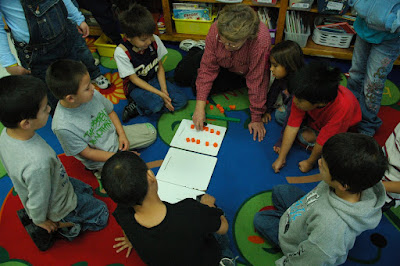For every young child, learning to count while simultaneously developing a sense of quantity is challenging work! Our data hints at the complexity hidden within the seemingly simple task of counting cubes.
 |
| 1st Grade Students Who Can Accurately and Consistently Count a Group of 21 Objects |
 |
| 1st Grade Students Who Can Accurately and Consistently Make a Pile of 18 Objects |
Why the discrepancy?
Counting is more than saying a rote sequence and recognizing a numeral. According to Kathy Richardson, "Counting is finding out how many."
When children first learn to count, they simply name the next number in the sequence without attending to the actual quantity. Kathy calls this the "land and count" stage. For children in this stage, the challenge is to count each object once and only one as they count and to keep track of how many they've counted. The answer to "How many?" is whatever number they happen to say last.
When children first learn to count, they simply name the next number in the sequence without attending to the actual quantity. Kathy calls this the "land and count" stage. For children in this stage, the challenge is to count each object once and only one as they count and to keep track of how many they've counted. The answer to "How many?" is whatever number they happen to say last.
During the "land and count" stage, children may have learned the importance of one-to-one correspondence, but they are still working to develop accuracy and a true idea of quantity. They will, for example, get different answers when recounting a group of objects without being bothered in the least. When a child is bothered by discrepancies in counting, we know that they are beginning to develop their sense of quantity.
But what is with the struggle to make a pile of 18 objects?
Difficulty in making a pile of 18 is a result of numbers lacking meaning for a child. Children who make these kinds of errors are still devoting their attention to the mechanics of counting - to keeping track, to saying the right number names, to putting their finger on the right object. As their comfort with counting grows, as they think more and more about "how many," they will also gain facility with holding a number in their mind as they count. They will be able to do this with or without distractions around them. In other words, when children perform poorly on this part of the assessment, the culprit isn't classroom distraction - it is lack of enough experience in really thinking about the question, "How many?"

No comments:
Post a Comment